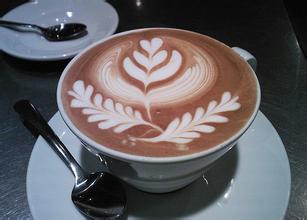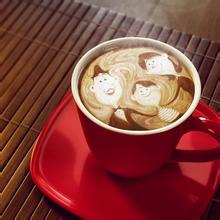Cappuccino cup size-how big is the fancy coffee cup?
Cappuccino cup size-how big is the fancy coffee cup?
When buying cups, many people are often unable to correctly distinguish between coffee cups and black teacups. Usually, in order to spread the aroma of black tea and appreciate the color of black tea, the bottom of the cup is lighter, the mouth is wider, and the light transmittance is higher, while the coffee cup has a narrower mouth, thicker material and low light transmittance. Coffee cups are generally ceramic cups and porcelain cups. Ceramic cups are suitable for coffee with deep baking and strong taste, while porcelain cups are suitable for coffee with a lighter taste.
Collectible cup
Many coffee fans like to collect all kinds of coffee cups, so some powerful coffee brands continue to launch specially designed cups for fans to collect. For example, illy will work with different designers to launch specially designed cups every year. Hong Kong star Chen Hao is a fan of illy coffee cups and will buy and collect them as soon as he sees them when he travels. Jackie Chan is also a fan of world-class famous porcelain coffee cups and saucers, with a collection of more than 600 sets.
Cappuccino cup generally choose thick-walled ceramic cup, mainly in order to ensure good thermal insulation performance, the diameter difference between the bottom and the mouth of the cup will not be very big, so the angle of the cup wall is generally about 100 degrees. The mouth of the cup is generally not very big, otherwise it is difficult to make a full effect of 12 points. The edge of the cup should not be plated, because many of the raw materials themselves have a certain impact on health, and the mouth of the cup is the part that we will directly touch with our mouth. The design of the cup handle is generally a ring, because the finger does not pass through the cup handle, so it may also be other shapes that are easy to handle.
Starbucks 8-ounce cappuccinos and 12-ounce cups of coffee are basically made with the same amount of coffee (Espresso), which means that "small cups" of coffee taste purer and better. In the rules of the World Barista Championships, the traditional cappuccino is defined as "five to six ounces of drinks (Five-to-six-ounce beverage)". If you buy a large cappuccino, pay so much RMB and buy a lot of milk instead of coffee.
Starbucks now sells cappuccinos in three sizes: medium (12 oz), large (16 oz) and oversized (20 oz). At present, the "small cup" specification can no longer be seen on the shop's price list, and it is said that it can be ordered if customers need it.
If you ask Starbucks why it is doing this? Technically, no matter how skilled a barista is, it is difficult to make a high-quality, large cup of cappuccino milk foam (called "Microfoam" in jargon).
As for why it is priced in this way? The economist's answer: this is Starbucks' painful choice in the face of a dilemma-prices are too low, profits disappear, prices are too high and customers are lost. But if your goods are too cheap, you may not be able to make money. Because a large number of customers who can afford to pay do not want to lose their price and step into the bargain store. As a result, companies do not usually drive down the prices of cheap products in order to prevent the loss of high-end customers and, like Starbucks, make cheap goods invisible.
In fact, this practice has existed for hundreds of years. As soon as the railway opened, the French economist Emile Dupuit wrote why the third-class carriages of the train were not roofed, even though it was cheap to build them, but "the company did so to prevent passengers who could afford second-class tickets from buying third-class tickets to travel; it hit the poor, but not to hurt them, but to scare the rich."

Important Notice :
前街咖啡 FrontStreet Coffee has moved to new addredd:
FrontStreet Coffee Address: 315,Donghua East Road,GuangZhou
Tel:020 38364473
- Prev

Introduction on how to grind Italian espresso beans
Introduction to how to grind espresso beans. In fact, I like this kind of coffee the least. It's tasteless and full of bubbles. Espresso (Espresso) or espresso is a type of coffee with a strong taste by brewing coffee with extremely hot but non-boiling hot water under high pressure and grinding it into a very fine coffee powder. It was invented and developed in Italy.
- Next

How to taste espresso-espresso tasting pdf
How to taste espresso-espresso tasting pdf 1. Generally speaking, the coffee shop produces espresso with a glass of water (room temperature) to clean the mouth so that you can better feel the taste of espresso. two。 By observing the color and state of cream, we can preliminarily judge the technology of making coffee at the bar and the freshness of coffee beans. 3. Equipped coffee spoon
Related
- Beginners will see the "Coffee pull flower" guide!
- What is the difference between ice blog purified milk and ordinary milk coffee?
- Why is the Philippines the largest producer of crops in Liberia?
- For coffee extraction, should the fine powder be retained?
- How does extracted espresso fill pressed powder? How much strength does it take to press the powder?
- How to make jasmine cold extract coffee? Is the jasmine + latte good?
- Will this little toy really make the coffee taste better? How does Lily Drip affect coffee extraction?
- Will the action of slapping the filter cup also affect coffee extraction?
- What's the difference between powder-to-water ratio and powder-to-liquid ratio?
- What is the Ethiopian local species? What does it have to do with Heirloom native species?

